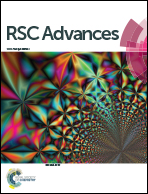PDMS membranes with tunable gas permeability for microfluidic applications†
Abstract
The air permeability of PDMS membranes is easily tuned by varying their composition. By varying the mixing ratio between oligomers and curing agent it is possible to strongly influence the chemical and mechanical properties of the elastomer resulting in a huge increase in the permeation of gas molecules across the membrane.


 Please wait while we load your content...
Please wait while we load your content...